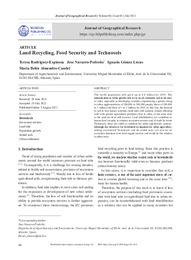Por favor, use este identificador para citar o enlazar este ítem:
https://hdl.handle.net/11000/34629Registro completo de metadatos
| Campo DC | Valor | Lengua/Idioma |
|---|---|---|
| dc.contributor.author | Rodríguez Espinosa, Teresa | - |
| dc.contributor.author | Navarro-Pedreño, Jose | - |
| dc.contributor.author | Gómez Lucas, Ignacio | - |
| dc.contributor.author | Almendro-Candel, María Belén | - |
| dc.contributor.other | Departamentos de la UMH::Agroquímica y Medio Ambiente | es_ES |
| dc.date.accessioned | 2025-01-16T18:12:47Z | - |
| dc.date.available | 2025-01-16T18:12:47Z | - |
| dc.date.created | 2021-08 | - |
| dc.identifier.citation | Journal of Geographical Research | Volume 04 | Issue 03 | July 2021 | es_ES |
| dc.identifier.issn | 2630-5070 | - |
| dc.identifier.uri | https://hdl.handle.net/11000/34629 | - |
| dc.description.abstract | The world population will grow up to 9.8 billion by 2050. The intensification in urban growth will occur on all continents and in all sizes of cities, especially in developing countries, experiencing a greater rising in urban agglomerations of 300,000 to 500,000 people, those of 500,000 to 1 million and those of 1 to 5 million, by 2035. In this way, the demand of soil to host human activities (land take) will increase, mainly affecting soils with greater agricultural potential close to cities, at the same time as the need for food will increase. Land rehabilitation can contribute to human food security, to enhance ecosystem services and, if made by waste Technosols, those are viable as substrate for urban agroforestry systems. Although the references for brownfield reclamation for urban agriculture, adding constructed Technosols and de-sealed soils can recover its ecosystem functions even food supply services and would be the solution in urban areas. | es_ES |
| dc.format | application/pdf | es_ES |
| dc.format.extent | 7 | es_ES |
| dc.language.iso | eng | es_ES |
| dc.publisher | Bilingual publishing group | es_ES |
| dc.rights | info:eu-repo/semantics/openAccess | es_ES |
| dc.rights | Attribution-NonCommercial-NoDerivatives 4.0 Internacional | * |
| dc.rights.uri | http://creativecommons.org/licenses/by-nc-nd/4.0/ | * |
| dc.subject | Brownfields | es_ES |
| dc.subject | Ecosystem services | es_ES |
| dc.subject | Land take | es_ES |
| dc.subject | Population growth | es_ES |
| dc.subject | Sealed soils | es_ES |
| dc.subject | Urban settlement | es_ES |
| dc.subject.other | CDU::6 - Ciencias aplicadas::62 - Ingeniería. Tecnología | es_ES |
| dc.title | Land Recycling, Food Security and Technosols | es_ES |
| dc.type | info:eu-repo/semantics/article | es_ES |
| dc.relation.publisherversion | https://doi.org/10.30564/jgr.v4i3.3415 | es_ES |

Ver/Abrir:
J Geographical Research-3415_V 4_Issue 03_2021.pdf
327,22 kB
Adobe PDF
Compartir:
 La licencia se describe como: Atribución-NonComercial-NoDerivada 4.0 Internacional.
La licencia se describe como: Atribución-NonComercial-NoDerivada 4.0 Internacional.
.png)